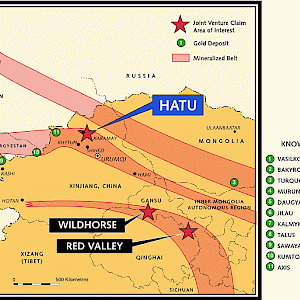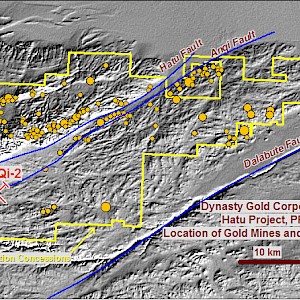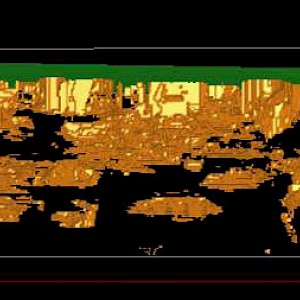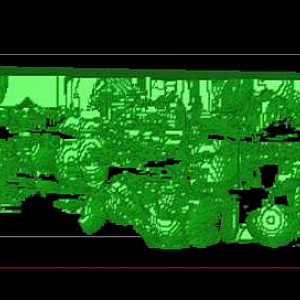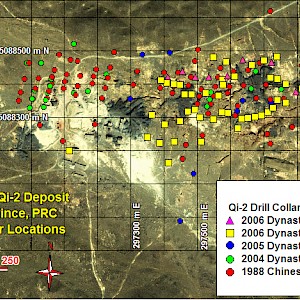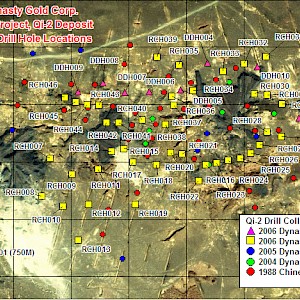Projects
Hatu, Xinjiang, China
Overview
Hatu Project Highlights

- Located in the world-class Tian Shan gold belt
- Adjacent to the Qi-2 gold deposit with inferred resources of 560,000 ounces of gold (8.7 million tons grading 2.00 g/t gold @ cut-off of 1.0 g/t gold)
- Excellent access to infrastructure
- The property is in dispute with the Chinese partner and the Company is pursuing a resolution.
Project History
In January of 2004, Dynasty received the business license for its 70%-30% Sino-Foreign Joint Venture (SJV) with Xinjiang NonFerrous Metals Industrial (Group) Co., (XNF). Dynasty can earn up to 80% of the SJV by spending US$12 million over the course of exploration. Dynasty acquired exploration licenses for 1000 square kilometres within an Area of Mutual Interest of 2500 square kilometres in Xinjiang Autonomous Region of Northwest China, and began exploration on the Hatu property in May of 2004. In March, 2006 Dynasty announced that its major shareholder, Avocet Mining, would spend US$1.8 million towards Dynasty's earn-in requirements. Avocet will earn 1% of Dynasty's joint venture for every US$50,000 spent at this stage. Avocet currently operates gold mines in Indonesia and Malaysia of a similar size and type as the Qi-2 deposit at the Hatu property.
Property Attributes
The Hatu property is located in the Tian Shan metallogenic belt. This package of rocks is host to several world-class gold deposits including Kumtor and Muruntau. (see Figure 2.) Access to the property is via flight from Beijing to the modern city of Urumqi , followed by a 4 hour drive on major highway to the city of Karamay and then by paved road less than one hour to the property. The Hatu property is crossed by dirt roads and power lines.
Geology and Mineralization
The Hatu property is located in the Junggar Basin between the Altay Shan and Tian Shan mountain ranges. The local geology consists of Devonian to Early Carboniferous metasediments, basalts and emplaced ophiolitic sequences, cut by NE trending faults. The property hosts over 300 known gold occurrences, some of which have been mined by the local Chinese population. Included in these occurrences is the Qi-2 gold deposit, an area of known gold mineralization with a history of small scale production, which became the focus of Dynasty's initial exploration efforts.
The Qi-2 deposit is hosted in carbonaceous volcaniclastic greenschist facies metasedimentary rocks in the footwall of the Anqi fault. Mineralization at the deposit is orogenic and the gold is structurally controlled and occurs along major faults and oblique intersecting minor faults. Alteration includes carbonatization, sericitization, and some propylitic and potassic alteration.
Exploration
In 2004 and 2005 Dynasty spent approximately US$3 million on exploration of the Hatu property. This included:
- Extensive geochem sampling and mapping
- Surface trenching and outcrop sampling
- Geophysical surveys
- 6200 metres of diamond drilling
- Remote sensing and satellite imagery
In June, 2005, a NI-43 101 compliant independent resource estimate was released by SRK Consulting citing an Inferred Resource of 912,600 ounces of gold. This includes approximately 16.9 million tons grading 1.68 g/t gold, at a cut-off grade of 1.0 g/t gold.
Results from the ground magnetics survey conducted in 2005 confirmed a large magnetic low coincident with the Qi-2 deposit. This is believed to correspond with mineralization and the survey was expanded to other areas in order to identify targets.
In 2005 drilling commenced in July around the Qi-2 deposit and nine drill holes were completed, for a total of 1960 m drilled. Three holes were placed near the centre of the deposit where previous drilling had been restricted to vertical holes. Structures in the deposit are steeply dipping, therefore the new holes were angled to better test the extent and orientation of mineralization. Three holes were drilled to the east of the deposit to test for new mineralization, as suggested by the magnetic survey data. All three holes encountered mineralization, including intercepts of 5.41 and 5.83 g/t Au. (See Dynasty News Release December 20th, 2005.) A final three holes were placed to test possible southern extensions of the deposit, based on the magnetic survey and surface geochemical results. Two of the holes, both situated more than 200 m from the centre of the deposit, encountered gold mineralization.
Dynasty’s US$1.8 million exploration program for 2006 commenced in April and included 8938 metres drilling for a total of 46 drill holes reverse circulation and 10 diamond drill holes. Most of the drilling was infill at the Qi-2 deposit, in order for Dynasty to have a new resource estimate completed. Dynasty also completed a second small set of metallurgical tests for the Qi-2 deposit. Results of the test can be found in the June 5th, 2007 news release. An additional 448 samples have been sent to Avocet’s Penjom gold mine in Malaysia for metallurgical testing using Avocet’s proprietary method.
In July 2007 SRK Consulting (Canada) Inc. released a revised resource estimate based on the 2006 drill program. The revised resource statement quoted total inferred resources of 8.7 million tonnes at an average grade of 2.00 g/t gold, for a total of 560,000 ounces of gold. For full details please see the July 3rd, 2007 news release.
In 2007 Dynasty completed a US$300,000 exploration program on the Hatu property. The program included 1,150 metres of trenching, the collection of 6,000 geochemical soil samples, a 210 kilometre ground magnetic survey, and the completion of 1:10,000 and 1:2,000 geochemical mapping.


